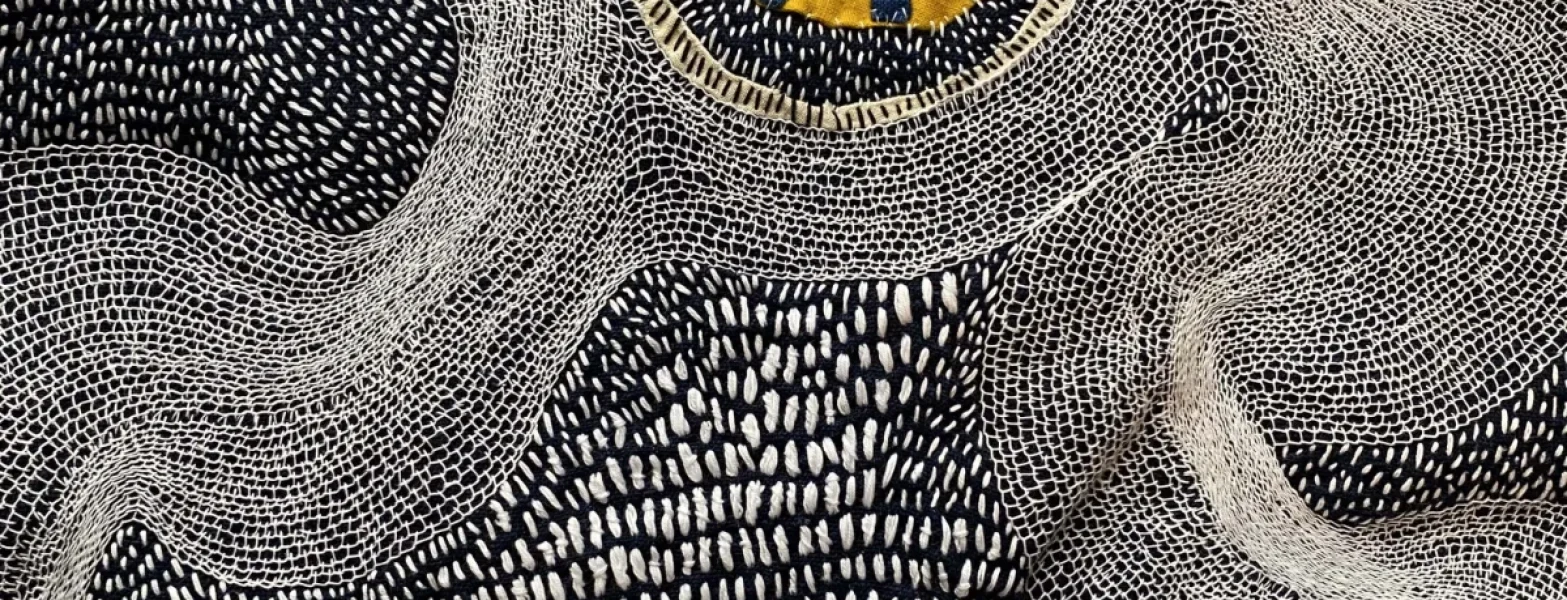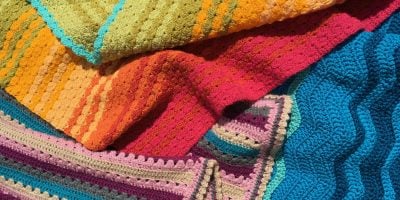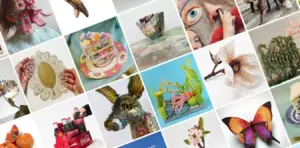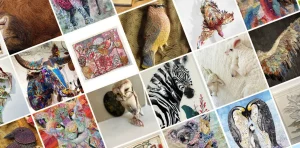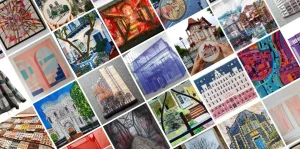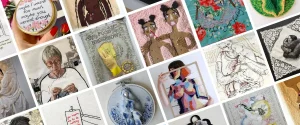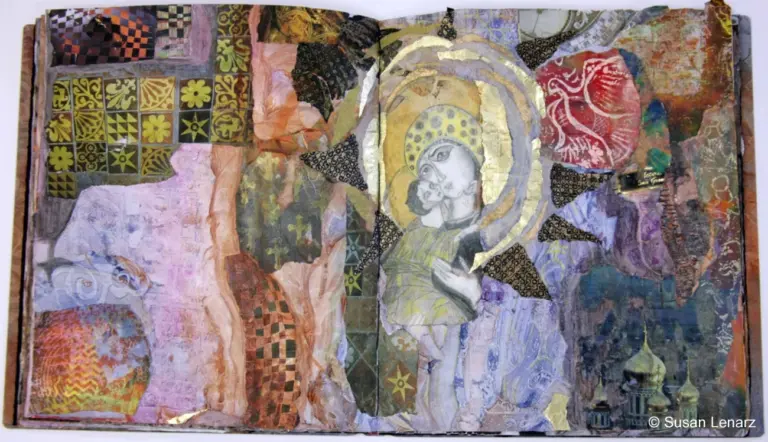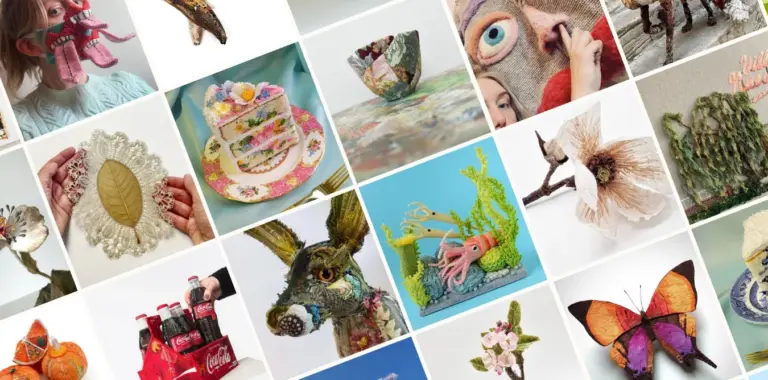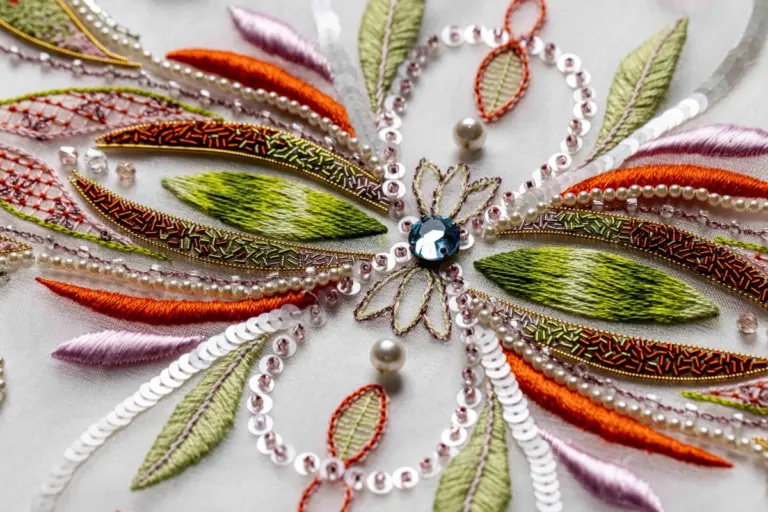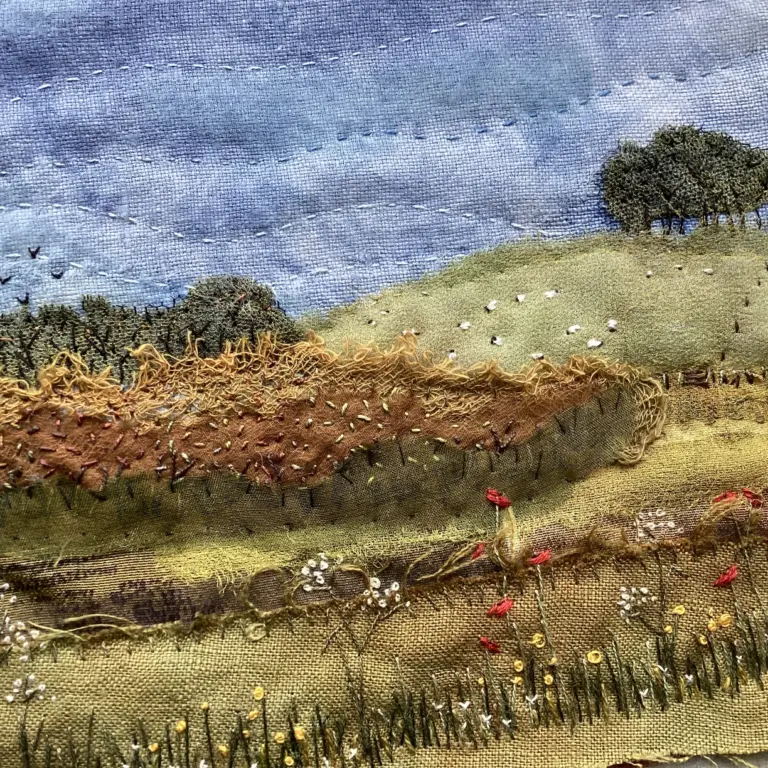Lindzeanne, a Tokyo-based self-taught textile artist, has captivated the art world with her unique approach to hand embroidery. Emerging from a background of vintage fashion and visible mending, she combines traditional techniques with modern aesthetics to create intricate and meaningful artworks. Lindzeanne’s work is distinguished by her use of simple stitches, primarily the blanket stitch and backstitch, to produce dense, detailed motifs that often incorporate circular patterns symbolizing wholeness and continuity.
Her creative journey began in the early 2010s within the visible mending community, driven by a passion for sustainability and anti-consumerism. This ethos is reflected in her preference for repurposing vintage textiles, transforming them into vibrant pieces that honor their history while injecting them with new life.
Inspired by the rich textile traditions of Japan, including sashiko and indigo dying, Lindzeanne’s art blends high contrast and repetitive mark-making to create visually compelling narratives, that catalogue the passage of time. Her work, though labor-intensive, is a testament to the power of patience and dedication, proving that small, consistent efforts can lead to remarkable creations. Despite the challenges of exhibiting her art in Tokyo’s competitive scene, Lindzeanne continues to gain recognition through social media, sharing her journey and inspiring others to embrace sustainable crafting practices.
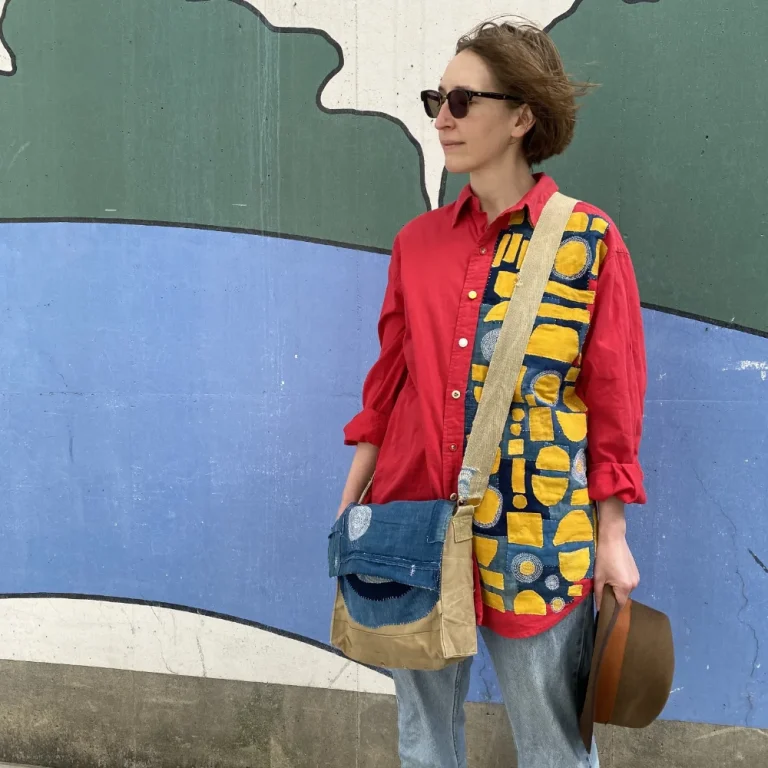
“My work is definitely inspired by sashiko and boro, although I do not claim to practice sashiko, and my work is certainly not boro. I like the high contrast of white thread on indigo, and how that contrast is, conducive? Useful? For repetitive mark making.”
Where did your journey with Hand Embroidery begin?
I don’t have a background in anything art related, I’m self taught. I don’t have any women in my family who sew or do any kind of craft or visual art either. But I had always wanted to! So I suppose I’m making up for lost time.
I have always been a pretty big advocate of anti consumerism, but also at the same time, like fashion and crafting my own style, so from a pretty young age I liked to go thrifting and vintage clothes shopping. Clothing, especially older clothing tends to wear down and out, so in an effort to maintain the things I loved, I fell into the early visible mending community around 2012-2014, and from there discovered embroidery. I don’t have much of an eye or talent for figurative work or illustration, and don’t have the patience to practice intricate embroidery or sashiko techniques, so once I found a few simple techniques I liked (like the blanket stitch and backstitch) I just winged it from there.

Tell us about a piece you’re currently working on
I’ve been working on this stained but deadstock bright blue French workwear coat since about October of 2023. At first I thought I would just do some light patchwork and applique for it for the fashion exhibition I joined in Osaka in December of 2023. I put down the first layer of patchwork on the back, and immediately didn’t like it, it looked too forced and kitsch. A deadstock jacket doesn’t really need repairs. So I decided to do really intricate embroidery on it, somewhat on a whim instead. I’m a big fan of primary colors, so I decided on yellow thread, thinking it looked really good with the blue.
The jacket has very intricate circles done in the blanket stitch. I like circular motifs for a lot of reasons. To me they represent wholeness. The verse in the poem Widening Circles by Rainer Maria Rilke “I live my life in widening circles that reach out across the world” has a deep personal meaning to me.
As a side note, through a lack of direction after quitting a music performance degree in the French horn at university, and a deep desire to avoid anything related to math or science, I accidentally got a history degree, specializing in Chinese-Tibetan relations and Indian and Nepalese theology and history. This is all to say that I became interested in the idea of the tradition of the prayer wheel from those cultures, and the spinning circular movement. I also find the meditation practice from India and Tibet known as “Tonglen” to be very beautiful.
To put it simply, it’s an exercise in compassion. As you breathe in, you consider another’s pain, taking it as your own, and as you breathe out you think love and compassion in their direction. It’s like little small prayers. Like silently saying to yourself when you see someone struggling, “yes, hello, I see you, I’m thinking good thoughts for you now, I hope these good thoughts will somehow benefit you.”
As I have worked on this jacket, even though it is based on my own colour preferences, it is very obvious that it also evokes the colours of Ukraine. So what was once a simple mending project has become a longer ongoing project. “Yes, hello, I see you, I’m thinking good thoughts for you now.” Not just for Ukraine. Anyone and everyone struggling, these are sad times. I don’t think I will cover the entire coat, but it’s certainly not done yet. I hope I can exhibit it one day.
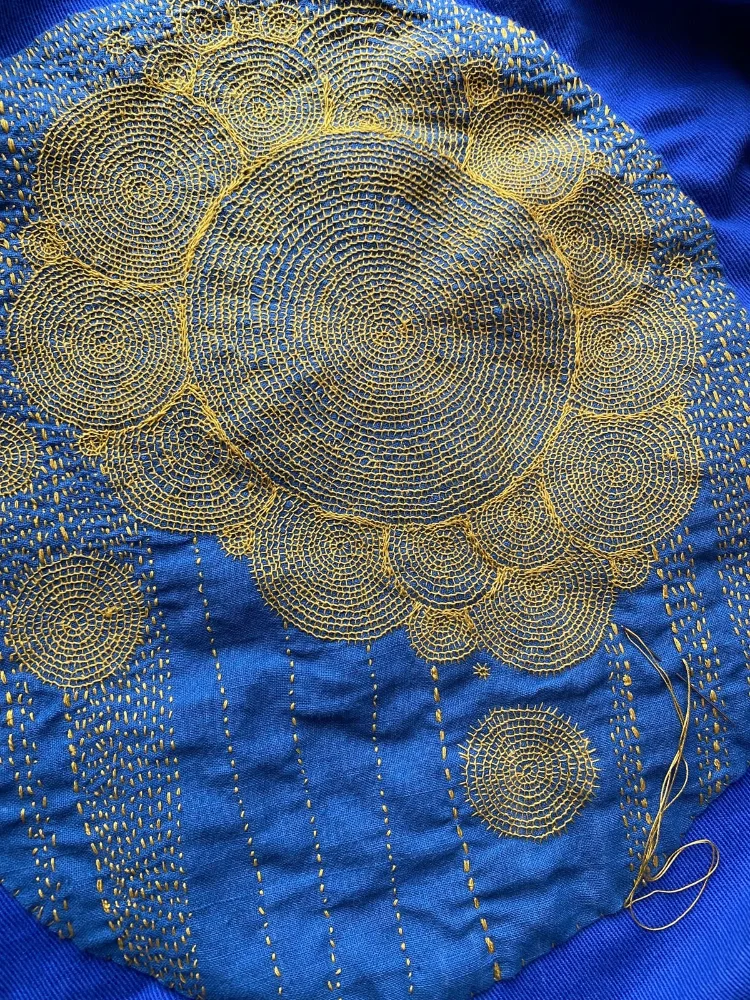
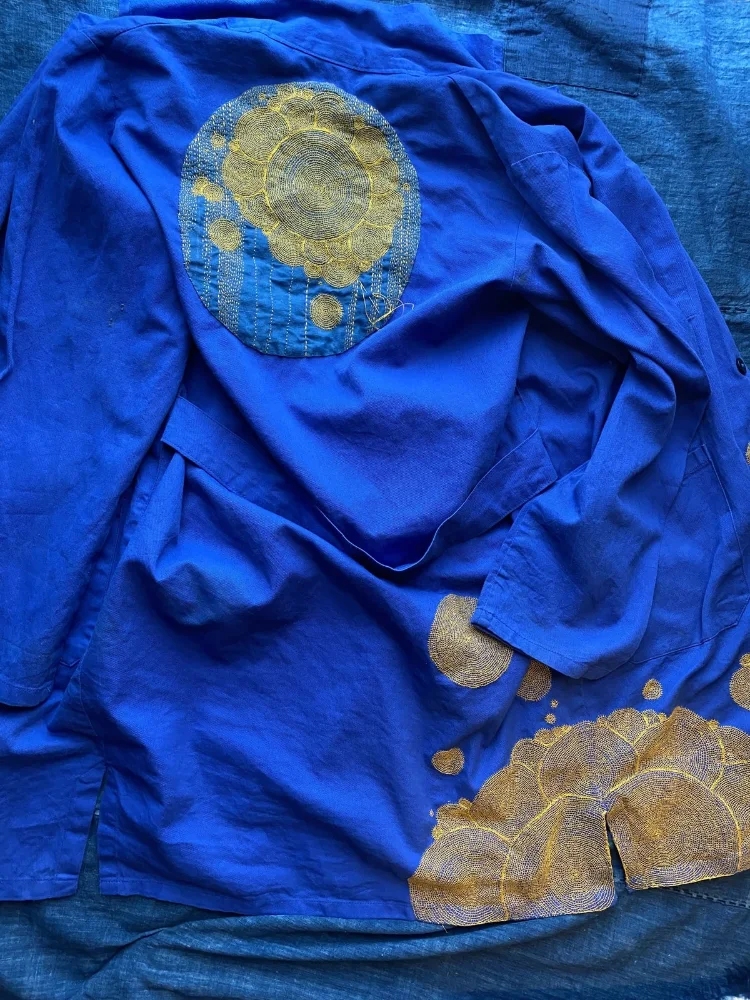

As someone based in Tokyo, Japan, how do you feel your location influences your work and designs?
My work is definitely inspired by sashiko and boro, although I do not claim to practice sashiko, and my work is certainly not boro. I like the high contrast of white thread on indigo, and how that contrast is, conducive? Useful? For repetitive mark making. There is also an abundance of beautiful antique and vintage textiles available to me, either gifted to me by generous friends and acquaintances or easily acquired at antique markets and shops. My work would look very different I think if I didn’t live where I live. I’m very grateful. I also really love the cityscape and architecture of Tokyo, all the buildings and angles.
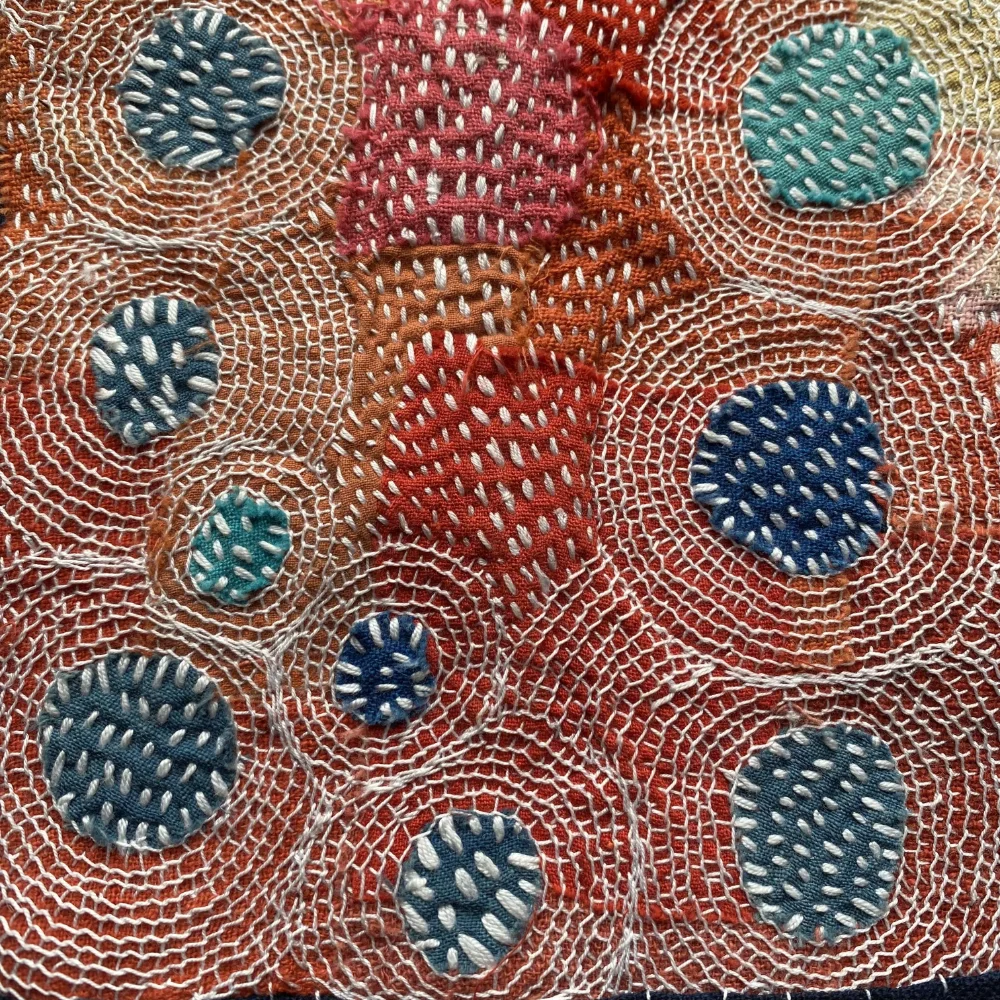
You use some very traditional techniques such as sashiko and indigo dyeing but bring them up to date in your work – can you talk us through your stitch and dye process for your pieces?
I sometimes dye things myself in my small Tokyo apartment kitchen, but I try to source colours rather than dye them myself. My work is labour intensive, and natural dye is an entirely different area of expertise I just don’t have the time to devote myself to at the moment. Maybe one day.
I only use the running stitch, common to sashiko, to mend my own clothing, because it’s practical and sturdy. I’m not familiar with all the different patterns and techniques to be honest. I don’t tend to read instruction manuals, or excel at following a pattern. I’m inspired by sashiko, but first and foremost the mark making aspect of it. I mimic sashiko with the backstitch, because with the backstitch I can make finer, denser marks. People have told me that my work reminds them or comes from horror vacui, and maybe that’s a good assessment. I want to fill a space as densely as I can.
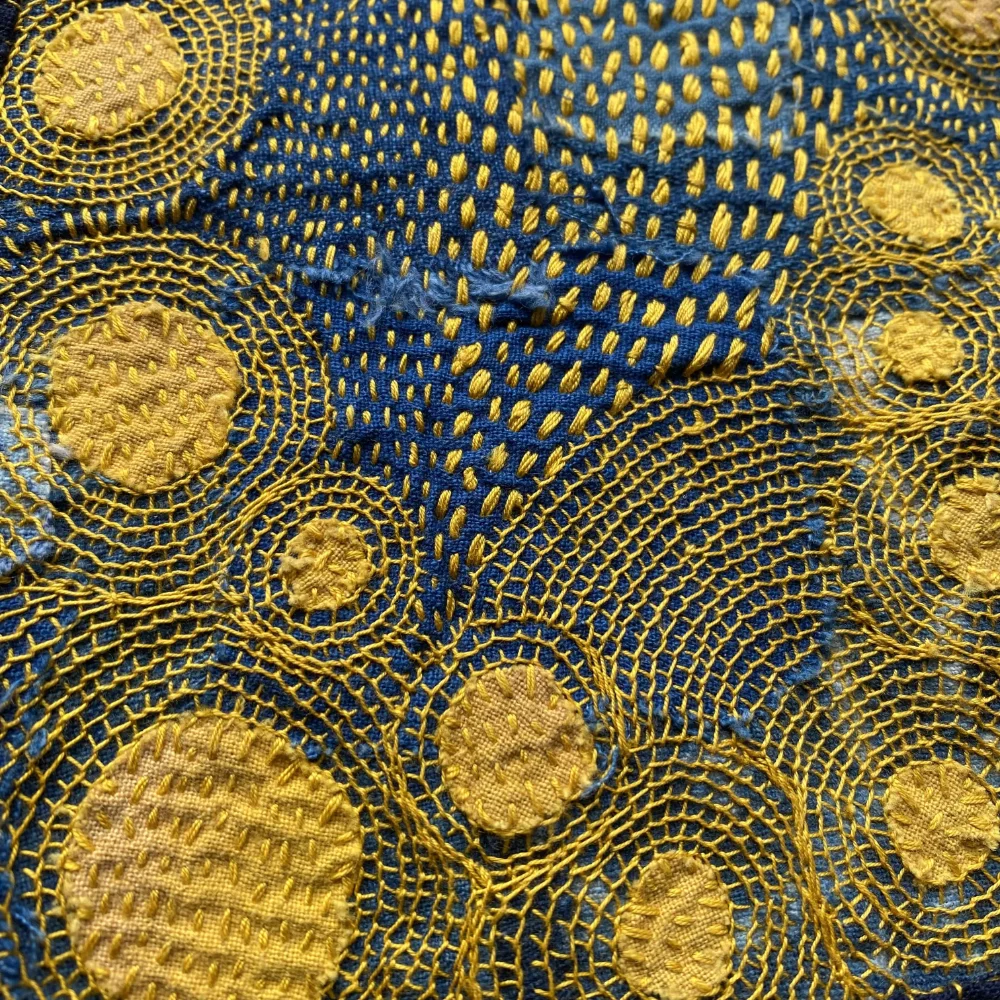
Why is using second hand or vintage textiles to create your pieces so important to you?
There are so many good quotes and statistics on and about textile waste. I highly recommend the book by Orsola de Castro, Loved Clothes Last. But the one statistic that has always stuck with me is that if we all stopped buying new clothes today, we would still have enough already made garments to clothe the next six generations of humans on the planet. That’s mind boggling to me. There is so much stuff already available. We don’t lack resources. But we might lack the creativity, or rather the focus and attention those resources already in existence deserve.
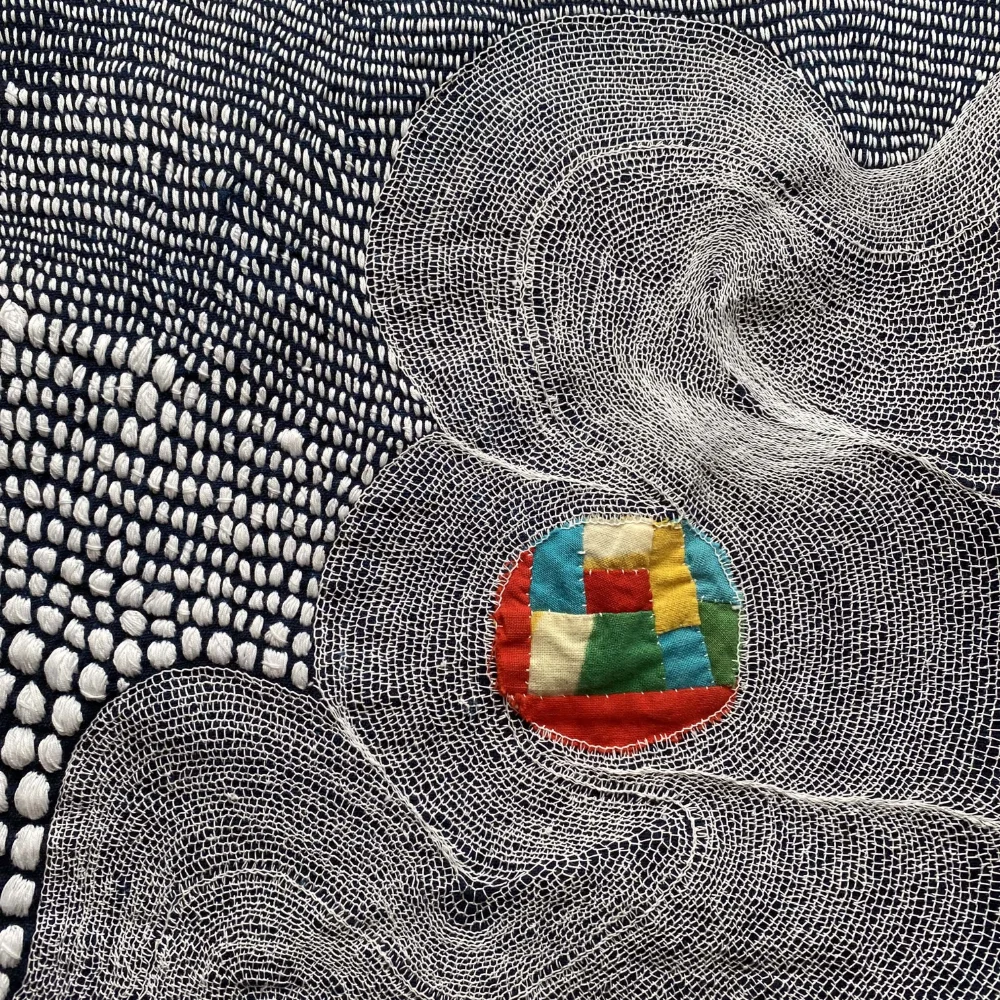
What advice do you have for our students who want to do more with recycled materials?
There is no time like the present! Things don’t have to be perfect. A step in this direction is better than no steps at all. My work is small and takes time, but it adds up eventually to something. Steps in the direction of lessening one’s environmental impact may be small, but they can add up to something too.
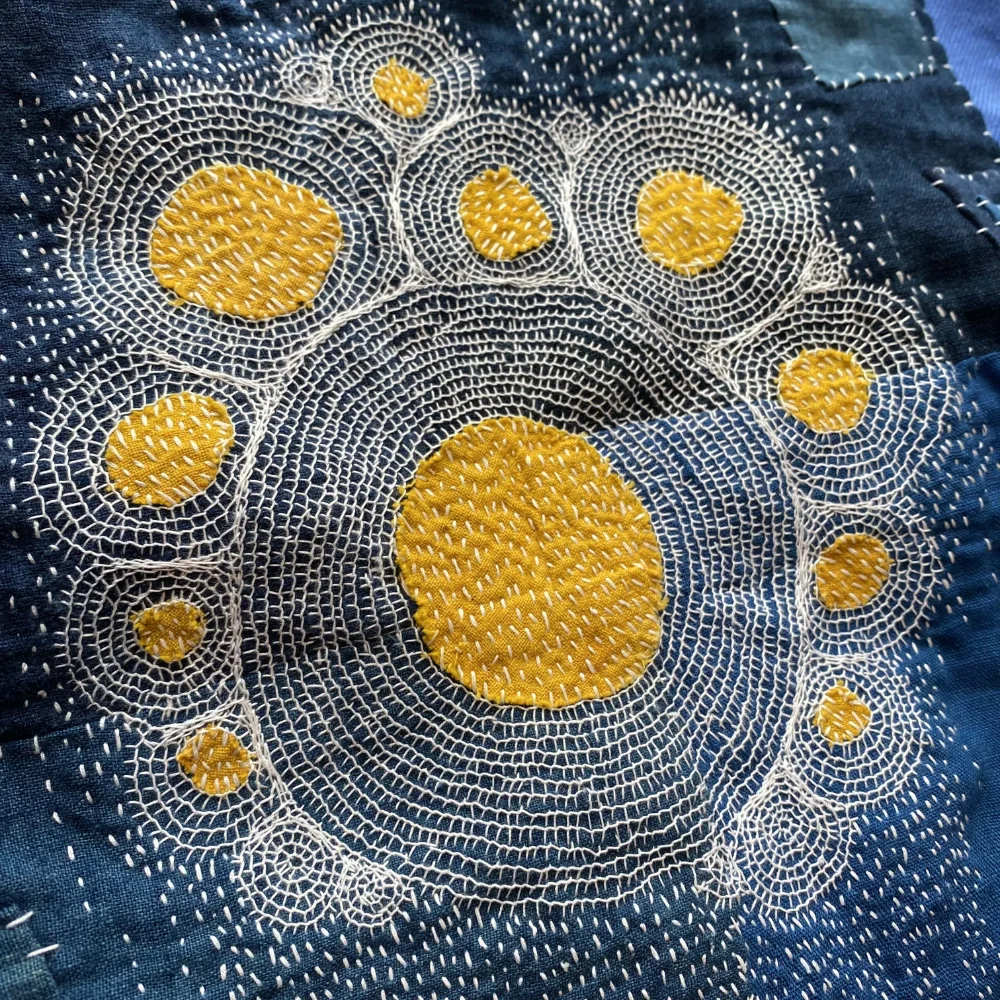
What artists inspire you personally?
I have a very long list! Because I am self taught I have a diverse but deep interest in a variety of artists I’ve come to feel a connection to. Here is my top ten ultimate dinner party guest list in no particular order:
- Paul Klee: His colour and patterns were the first visual artist I really fell in love with. I hope he would draw me an angel on a dinner napkin.
- Joan Miro: I’m just obsessed with his color palette and his body of work “Constellations”
- Ayako Miyawaki: The Japanese applique artist. She also used repurposed fabrics. I bet she would have all the good details on where to find cool textiles.
- Sophie Taeuber-Arp: Her work is so playful, but her designs are so bold and confident. I appreciate her multidisciplinary work.
- David Bowie: I mean, come on, it’s David Bowie.
- Louise Bourgeois: I love her work, but her as a person moreso. Her childhood and relationships within her family resonates with me. Hearing how she transposed her anger into art was cathartic. I would like to tell her thank you.
- Alexander Calder: His colours, his playfulness. He seems like he would be fun to have a drink with. I would want him to show me his miniature circus performance after dinner.
- Tetsuko Kuroyonagi: The Japanese actress and celebrity. Her autobiography “Toto chan: The Little Girl by the Window” is an excellent and heartbreaking read about her alternative education leading up to World War II. It’s always inspired me to be a better educator. I would like to tell her thank you too.
- Rieko Koga: A contemporary embroidery artist who is currently based in Paris. I would love to just have a chat with someone else who does abstract embroidery.
- Atsuko Tanaka: The Japanese artist from the Gutai movement. I just love her work. Maybe she could model her light dress.
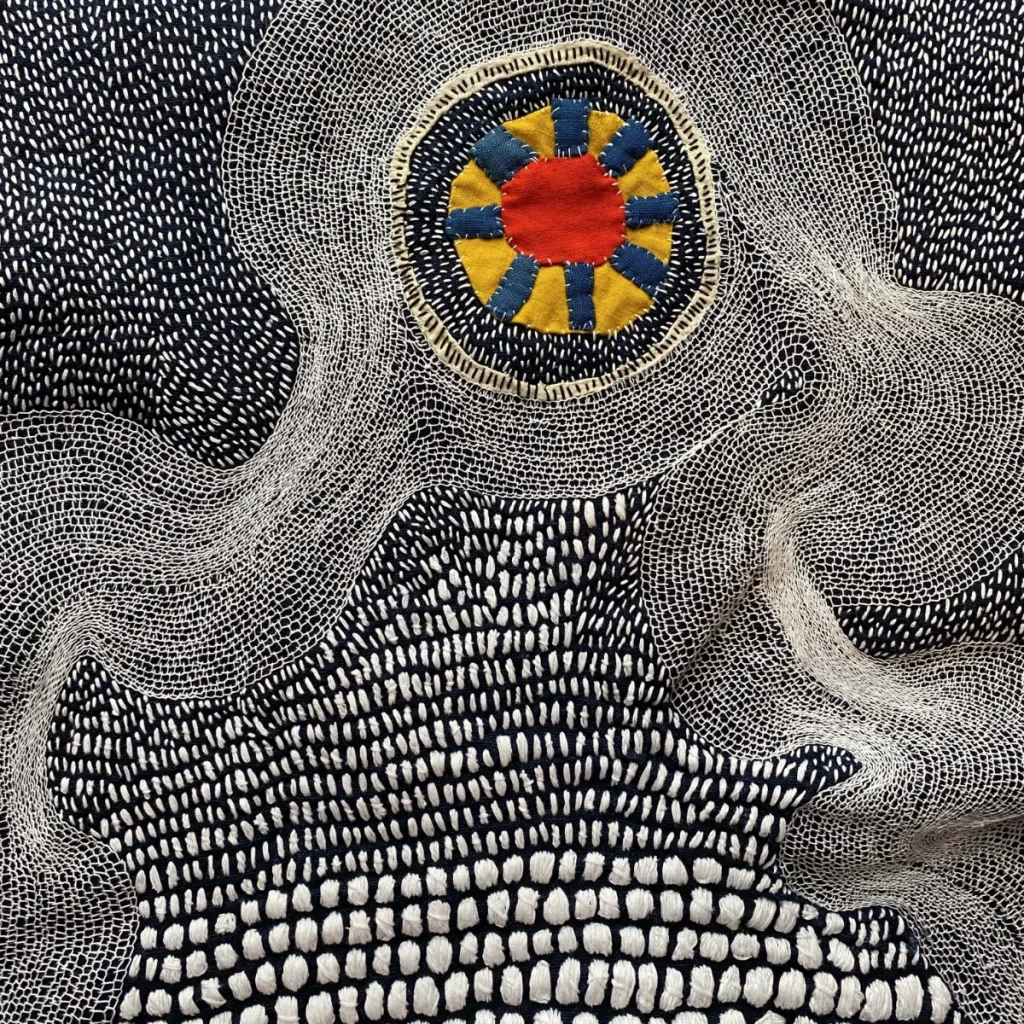
What do you have coming up?
I’m not sure! I wish I could exhibit more, but I don’t really know how to be honest. Exhibiting in galleries in Tokyo isn’t exactly easy without a lot of art connections or pedigree. I’m not that free to travel due to my day job and my current visa restrictions. I support myself by teaching English, but I would certainly love to one day be able to devote more of my time to my work. I feel like I got a lot of sudden attention through Instagram, which I’m grateful for. However, I am very much a new-to-the-scene artist just trying to make my work and do my best.
Show your appreciate and give Lindzeanne your support by visiting her website or follow her on Instagram.
Key Takeaways
Lindzeanne’s experiences and insights offer valuable lessons in creativity, sustainability, and personal expression, encouraging textile artists, crafters, and makers to find their own path and voice in their work. Here’s what we’ve learned.
Self-Taught and Passion-Driven: Passion and dedication can lead to success in creative fields. It’s never too late to start crafting and self-education is a viable path.
Embrace Simple Techniques: Lindzeanne prefers straightforward stitches like the blanket stitch and backstitch, proving that simple techniques can create intricate and impressive designs.Finding and mastering a few basic stitches can be more effective than trying to learn every technique.
Repurpose and Sustain: Lindzeanne advocates for using second-hand or vintage textiles, highlighting the environmental benefits and creative possibilities of repurposing materials.This approach not only reduces waste but also adds a unique historical dimension to the work.
Creative Problem Solving: When her initial design for a project didn’t meet her expectations, Lindzeanne pivoted and transformed it into a more intricate and meaningful piece. Flexibility and willingness to adapt can lead to unexpected and rewarding outcomes.
Inspiration from Tradition and Culture: Lindzeanne draws inspiration from traditional Japanese techniques like sashiko and boro, even if she doesn’t strictly adhere to them. Incorporating elements of cultural heritage can enrich and deepen the significance of contemporary work.

